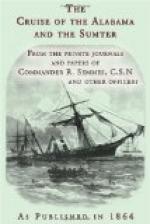Accordingly, for the next ten or twelve days the Alabama lay helplessly on the ocean, tossed and beaten about by a succession of gales from every point of the compass, culminating, as we have seen, in the hurricane of the 16th October. The season was, indeed, most unusually severe, this month of October being commonly one of calm and fine weather. A gale at this time is a most unusual occurrence; but for more than a week a succession of storms was experienced of the most violent description, while for fully three weeks the weather continued dark, rough, and gloomy, with strong shifting winds and heavy rain, the thick clouds rarely separating sufficiently to afford the chance of an observation.
Occasionally a break in the murky canopy would give promise of a change for the better; but a very few hours served to dissipate the rising hope. The sky would be again overcast, the wind breeze up from a fresh quarter, and another night of discomfort set in. In addition to this adverse weather, a still further difficulty was experienced in the strong current that appeared to set continuously from the westward, drifting the vessel bodily out of her course at the rate of sixty or seventy miles a day. During this period, the barometer ranged from 28.64 to 29.70. It was remarkable that the winds appeared to succeed each other with perfect regularity, rotating, as nearly as possible, once in every two days, or at the utmost, in two days and a half. The course taken by these rotatory storms was always the same, and it was a rare occurrence for the wind to remain stationary in one quarter during eight or ten successive hours.
On the 23rd October the gale at last finally broke, and with the return of better weather the Alabama’s luck seemed also about to revive. At noon a brief break in the clouds just gave time for an observation for latitude, and this was barely worked out, when “Sail, ho!” was heard from the masthead; and a fine brig was discovered hull down on the lee bow. Running down to her under close-reefed topsails, she proved to be English; but though not destined herself to become a prize, the deviation in the Alabama’s course, occasioned by the chase, proved most fortunate for her. She had scarcely luffed up again, after ascertaining the brig’s nationality, when again the welcome cry was heard, and the helm shifted in pursuit. Soon the new chase became clearly discernible from the quarter-deck, when she proved to be a large ship running to the northward and eastward under a press of canvas. So determinedly was she “cracking on” as to have everything set, even to her main-royal, notwithstanding that the wind was still blowing very nearly half a gale.
The course of the stranger being diagonal to that of the Alabama, the speed at which she was travelling soon brought her within speaking distance, and, as usual, a feint was made for the purpose of extorting a confession of her nationality. The flag chosen this time was the English blue ensign, and it was speedily answered by the Stars and Stripes, which fluttered gaily from the merchantman’s peak as she dashed along under her towering mass of canvas before the breeze, right across the Alabama’s path.




